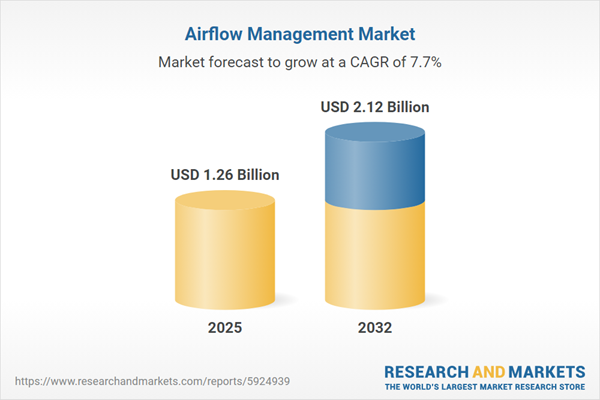Speak directly to the analyst to clarify any post sales queries you may have.
The airflow management market is pivotal for organizations seeking efficient operations, regulatory compliance, and sustainability. As digital transformation accelerates, leaders increasingly prioritize investments in advanced airflow solutions to strengthen facility performance and future-proof infrastructure.
Market Snapshot: Airflow Management Market Size and Growth Trends
The global airflow management market secured a valuation of USD 1.17 billion in 2024 and is projected to expand to USD 1.26 billion by 2025, with further growth reaching USD 2.12 billion by 2032. This upward trend highlights rising demand for dependable operations amid tightening regulatory frameworks and growing infrastructure complexity. Organizations are increasingly choosing airflow management solutions to lower operational risks, streamline technology integration, and enhance system reliability. These decisions are influenced by a dynamic market climate, where aligning with best practices and compliance mandates is essential for sustained competitiveness.
Airflow Management Market: Scope & Segmentation
- Product Types: Electric actuators, hydraulic actuators, pneumatic actuators, manual dampers, motorized dampers, louvers, mass flow controllers, pressure flow controllers, rotameters, and specialized valves including ball, butterfly, control, and gate valves. Each product class supports targeted operations, from managing complex industrial workflows to enabling core system functionalities within critical installations.
- Application Areas: Found in diverse sectors such as industrial chemical operations, high-density data centers supporting digital infrastructure, clean rooms requiring strict air quality, nuclear and thermal power plants, metals processing, petrochemical and pharmaceutical manufacturing, biopharmaceutical facilities, defense uses across air and naval sectors, and advanced residential settings driven by smart home technology.
- Regions Profiled: United States, Canada, Mexico, Brazil, Argentina, Chile, Colombia, Peru, major European economies, the Middle East, Africa, China, India, Japan, Australia, South Korea, and Southeast Asia, each presenting distinct environmental and regulatory considerations that influence system design and supplier strategies.
- Core Technologies & Capabilities: Intelligent sensing technologies enable real-time and predictive monitoring; cloud-based analytics facilitate strategy development; advanced filtration enhances air quality control; adaptive interfaces support renewable energy integration; and adoption of circular economy models maximizes infrastructure longevity and resource efficiency.
- Leading Industry Players: Key suppliers include Honeywell International Inc., Siemens Aktiengesellschaft, Schneider Electric SE, Johnson Controls International plc, Emerson Electric Co., ABB Ltd., Danfoss A/S, Mitsubishi Electric Corporation, Rockwell Automation Inc., and Nidec Corporation. These organizations contribute to solution stability and advance innovation in multi-site, global operations.
Key Takeaways for Senior Decision-Makers
- Digital enhancements in airflow management deliver improved visibility and adaptability, allowing for effective navigation of evolving compliance landscapes and swift regulatory change.
- Sustainable material adoption and next-generation filtration foster environmentally responsible operations and maintain robust performance in environments where reliability is critical.
- Modular system deployment minimizes operational disruption, providing a strategic path for phased upgrades and seamless technology integration with existing infrastructure.
- Collaborative engagement with supply partners and strategic data analytics increase transparency, optimize procurement, and focus improvements across value chains.
- Tailored solutions that address diverse regional regulations and environmental factors help organizations anticipate risks and ensure operational alignment, regardless of jurisdiction.
- Growing interconnectivity across facilities and procurement platforms underlines the importance of rigorous cybersecurity measures to safeguard business continuity and asset security.
Tariff Impact: U.S. Policies Reshaping Supply Chains
Evolving United States tariff regulations are influencing global sourcing strategies for airflow system components. Organizations must revise purchasing decisions, expand supplier networks, and elevate risk management to sustain supply chain resilience and control costs in rapidly shifting trade environments. Heightened emphasis on procurement flexibility and supply chain evaluation enables organizations to proactively address disruptions resulting from international policy changes.
Methodology & Data Sources Supporting the Airflow Management Market
This market analysis uses expert interviews, a critical review of sector literature, and proprietary data analytics. The approach supports thorough value-chain evaluation and provides scenario-based tools for leaders adapting to regulatory and operational changes.
Why This Report Matters
- Delivers essential guidance for executives seeking to prioritize investments, modernize technology ecosystems, and reduce exposure to supply chain risks.
- Clarifies the impact of regional and regulatory developments, equipping leaders to make informed choices as operational and compliance landscapes evolve.
- Enables high-confidence supplier benchmarking and supports decisions that drive ongoing operational modernization and strategic differentiation.
Conclusion: Guiding Strategic Investments and Innovation
This report provides the actionable insights senior leaders require to support innovation, safeguard operational standards, and ensure alignment with sustainability and compliance targets in the airflow management market.
Additional Product Information:
- Purchase of this report includes 1 year online access with quarterly updates.
- This report can be updated on request. Please contact our Customer Experience team using the Ask a Question widget on our website.
Table of Contents
3. Executive Summary
4. Market Overview
7. Cumulative Impact of Artificial Intelligence 2025
Companies Mentioned
The companies profiled in this Airflow Management market report include:- Honeywell International Inc.
- Siemens Aktiengesellschaft
- Schneider Electric SE
- Johnson Controls International plc
- Emerson Electric Co.
- ABB Ltd
- Danfoss A/S
- Mitsubishi Electric Corporation
- Rockwell Automation, Inc.
- Nidec Corporation
Table Information
| Report Attribute | Details |
|---|---|
| No. of Pages | 187 |
| Published | October 2025 |
| Forecast Period | 2025 - 2032 |
| Estimated Market Value ( USD | $ 1.26 Billion |
| Forecasted Market Value ( USD | $ 2.12 Billion |
| Compound Annual Growth Rate | 7.7% |
| Regions Covered | Global |
| No. of Companies Mentioned | 11 |









